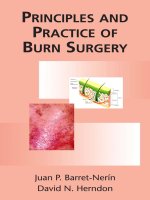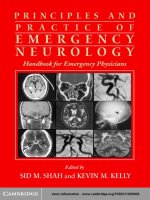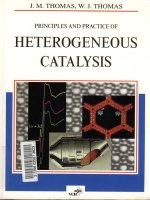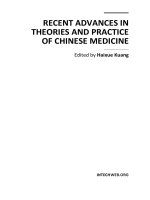Ebook Principles and practice of aviation medicine: Phần 1
Bạn đang xem bản rút gọn của tài liệu. Xem và tải ngay bản đầy đủ của tài liệu tại đây (1.78 MB, 431 trang )
PRINCIPLES AND
PRACTICE OF
AVIATION MEDICINE
This page intentionally left blank
PRINCIPLES AND
PRACTICE OF
AVIATION MEDICINE
editors
Claus Curdt-Christiansen
International Civil Aviation Organization, Montreal
Jörg Draeger
University of Hamburg, Germany
Jürgen Kriebel
Aero Medical Center, Lufthansa AG, Frankfurt, Germany
World Scientific
NEW JERSEY
•
LONDON
•
SINGAPORE
•
BEIJING
•
SHANGHAI
•
HONG KONG
•
TA I P E I
•
CHENNAI
World Scientific Publishing Co. Pte. Ltd.
5 Toh Tuck Link, Singapore 596224
USA oflce: 27 W m n Street, Suite 401-402, Hackensack, NJ 07601
UK oflce: 57 Shelton Street, Covent Garden, London WC2H 9HE
Library of Congress Cataloging-in-PublicationData
Principles and practice of aviation medicine / editors, Claus Curdt-Christiansen,
Jorg Draeger, Jiirgen Kriebel.
p. ;cm.
Includes bibliographical references and index.
ISBN-13: 978-981-238-861-2 (hardcover : alk. paper)
ISBN-10: 981-238-861-3 (hardcover : alk. paper)
I. Aviation medicine. I. Curdt-Christiansen, Claus. 11. Draeger, Jorg,
Prof. Dr. 111. Kriebel, liirgen.
[DNLM: I. Aerospace Medicine--methods. 2. Aerospace Medicine--standards.
WD 700 P952 20091
RC1062.P75 2009
616.9'80213--dc22
Hrilish Library Calaloguislg-in-Publicaliun Data
A zatalogue retorJ for thla hook
is
a\3lllblc from the Br;ll>h Llbrdr)
Copyright 0 2009 by World Scientific Publishing Co. Re. Ltd.
AN rights resemed. This book, orparts thereoJ may not be reproduced in anyform or by any means,
electronic or mechanical, includlngphotocopying,recording or any information storage andrefrieval
system now known or to be invented, without writtenpermissionfrom the Publisher.
For photocopying of material in this volume, please pay a copying fee through the Copyright
Clearance Center, Inc., 222 Rosewood Drive, Danvers, MA 01923, USA. In this case permission to
photocopy is not required from the publisher
Typeset by Stallion Press
Email:
Printed by FuIsland Offset Printing (S) Pte Ltd. Singapore
This page intentionally left blank
Prologue
Aviation is at the heart of world development. Man, with all his physical
and mental shortcomings, is at the heart of aviation. But just as
modern life is inconceivable without aviation, aviation cannot exist
without its weakest link, the human being. The aviation environment,
however, is hostile to humans. Soon after the first balloon flights
more than 200 years ago, it became clear that man was unable to
function and survive at altitude without special protection and support. With the advent of powered flight more than 100 years ago, the
need for physiological and medical support became obvious.
Doctors supporting the military flight operations of World War I realized that selection criteria had to be developed to reduce the high
number of losses of both aircraft and pilots. Following the Peace
Conference in Paris in 1919, the first international medical requirements for licensing of aviators were agreed upon, and over the ensuing years these international standards have been further developed.
Since then powered flight has evolved considerably and so has the
specialty of aviation medicine. The medical standards for licensing of
pilots, i.e. the medical requirements an applicant must meet to be
accepted for initial training and which all trained and licensed pilots
must meet at their regulatory renewal examinations, have always
been restrictive and conservative. This is an obvious necessity. The
purpose of the requirements is to maintain and secure the high level
of safety that characterizes modern aviation — a goal that leaves little
v
vi
Prologue
room for experimenting with or relaxing the requirements. However,
many medical conditions that were considered permanently disqualifying in the past are now allowed as a result of continuous improvement
in our understanding of the physiology of flight, the evolution of
evidence-based medicine, and the vast technical advances of recent
years in diagnosis and treatment.
All medical standards have three different aspects that always must
be considered together. The first is the requirement per se,
e.g., epilepsy entails unfitness for all classes of medical certification, or
blood pressure shall be within normal limits. The second aspect is the
method or methods traditionally employed or sometimes prescribed by
the Licensing Authority for carrying out the examination. The third
aspect is the definitions applied to the requirements. For example, how
is epilepsy defined or what are the normal limits for arterial tension?
Although most countries have accepted the international standards and
recommended practices developed and continually updated by the
International Civil Aviation Organization (ICAO), there are still significant differences from one country to another pertaining to the methods
of examination. Examining the visual fields of a pilot by confrontational testing with finger movements compared to examining by automated, computerized perimetry provides results on very different levels
of reliability. The use of different methods of examination vary from
country to country is hardly a surprise; different countries have different cultures, different socio-economical conditions, different prevalences of many diseases, different medical traditions, and different
attitudes to the relevance of safety precautions.
Modern civil aviation, however, is international. A modern
airliner has the same needs and demands for ground support wherever it happens to be in the world. Almost 200 countries are currently
connected with each other by regular commercial flights and none
can afford to reject the international community and refuse to provide
the infrastructure necessary to ensure the safety of aviation. All signatories to the Convention on International Civil Aviation (“Chicago
Convention”) of 1944, currently totaling 191 countries, have undertaken to collaborate in securing the highest practicable degree
of uniformity in relation to aircraft, aviation personnel, licensing
Prologue
vii
procedures, etc., including medical certification of pilots and air traffic controllers. Even so, there are still significant differences regarding national approaches to aeromedical certification. To some extent,
these differences are related to the influence that military aviation
medicine has had upon civil aviation medicine. Also relevant is the
comparative level of development that aviation medicine (as a medical specialty) has reached in different countries. While in some
countries aviation medicine was a highly-developed medical specialty even before World War II, in other countries aviation medicine
is only beginning to establish itself as a recognized specialty.
Most countries have agreed on the need to implement medical
requirements for aviation personnel and have adopted the ICAO
International Medical Standards and Recommended Practices or
developed their own medical standards in accordance with the ICAO
provisions. The next step towards uniformity in medical certification
must be to help medical examiners and medical assessors worldwide
adopt similar methods of examination and similar definitions of
diseases and disorders. In particular, agreement on definitions and
similar interpretation of the signs and symptoms of diseases and
disorders are required if global harmonization in aeromedical certification is to be achieved.
This book contains detailed, experience-based, practical knowledge written to assist aviation medical examiners (AMEs) and other
clinicians, as well as medical assessors of the Licensing Authorities, in
the often confusing world of medical treatment and aeromedical
evaluation of safety-critical aviation personnel such as pilots, cabin
crew members, and air traffic controllers. In addition, it provides medical guidelines for physicians who have patients with medical conditions who wish to travel by air. This book is written by AMEs and
clinicians from a wide range of medical specialties that are important
to the field of aviation medicine. It initially began as a reference book
for German physicians who may or may not be AMEs, yet who are
involved in the health care of pilots. It has expanded to this current
English version to address an international audience in order to provide guidance and advice to colleagues in the practice of clinical aviation medicine. Considering the European background of the authors,
viii
Prologue
this book represents European points of view and international or
European criteria regarding the determination of fitness for duty
among civil aviation personnel. It is, nonetheless, an excellent and
detailed international guide for medical practitioners in all parts of the
world who deal with aircrew members and airline passengers.
Aviation medicine is a scientific discipline that involves the study
of the physiological, psychological, operational, and environmental
factors that determine the adaptive responses of a human being
during flight. With regard to flight crews, the focus is different from
that of the “conventional” clinical specialties which primarily deal
with abnormal physiology within a normal environment, as it is concerned with normal physiology within an abnormal environment.
With regard to passengers, however, conventional and aviation medicine intersect because at times abnormal physiology may be placed
within an abnormal environment. This is also the case when it comes
to determining exactly to what degree, i.e., with what limitations or
restrictions or under what conditions, a pilot with a medical disorder
may be able to perform his duties without endangering flight safety.
It is to this highly specialized field of clinical aviation medicine that
most chapters of the book are dedicated.
Flying represents a hostile environment that imposes a variety of
physical, physiological, and psychological demands on human
beings who are not genetically adapted to function in such an environment. Promoting the health and well being of aviation personnel
worldwide is essential for the safety of all flight operations in civil
aviation. It is also very important to recognize the potential consequences that the flight environment can have on those individuals
who have pre-existing medical conditions and wish to travel by air or
are required to be transported or medically evacuated by aircraft.
Therefore, medical practitioners must possess basic knowledge of
aviation physiology and medicine in order to make appropriate decisions
concerning medical certification of pilots and other flight personnel.
Such knowledge is also essential in making the correct decisions
concerning the safe medical transport of diseased passengers aboard
commercial aircraft or the medical transport (elective or emergency)
of patients by air ambulance.
Prologue
ix
Most university programs that train medical professionals do not
include instruction in the basic principles of aviation physiology or
medicine. Some countries offer basic and advanced post-graduate
training in aviation medicine, but very few offer formal residency programs (specialty) in aviation medicine. Therefore, this book will benefit medical practitioners in many countries that do not have national
access to post-graduate training in aviation medicine. It will also be a
good source of clinical, aeromedical knowledge for those who are
enrolled in post-graduate training programs in aviation medicine.
Any professional publication that contributes to our existing
body of knowledge in aviation medicine is very welcome since
there are not many up-to-date publications that specifically address
the clinical aspects of aviation medicine. Therefore, this book represents an important addition to the international literature on aviation
medicine in general, and to its clinical aspects in particular.
The contributing authors’ knowledge of aviation medicine,
significant clinical experiences, and international professional recognition among colleagues make this book an excellent addition to any
aviation medicine practitioner’s personal library.
Dr. Melchor Joaquín Antuñano
Director, Civil Aerospace Medical Institute —
Federal Aviation Administration
Past-President and Fellow,
Aerospace Medical Association
Past-President, Space Medicine Society
Past-President, Iberoamerican
Association of Aerospace Medicine
Member and Chancellor of the International
Academy of Aviation and Space Medicine
Member of the International Academy of Astronautics
Honorary Member of the Colombian, Greek,
Brazilian, Mexican, Slovenian and Turkish
Aerospace Medicine Societies
This page intentionally left blank
Preface and Acknowledgement
Aviation medicine is a medical specialty which combines aspects of
preventive, occupational, environmental and clinical medicine with
the physiology and psychology of man in flight. It is concerned with
the health and safety of those who fly, both crew and passengers, as
well as the selection and performance of those who hold aviation
licences.
This book provides practice-oriented information on evaluation
of fitness to fly and medical certification of those who want to
acquire or maintain an aviation licence. The focus is on uniform
methods of examination and assessment of pilots, both professional
and private, cabin crew members, and air traffic controllers. In order
to increase the book’s clarity and usefulness for practical application,
common diseases and disorders are discussed; those rarely encountered in aviation medicine practice are excluded.
A symbolic summary of this book is depicted on the cover by the
“aeromedical homunculus.” As the area of anatomical representation
increases with the complexity of the sensory-motor function, the
sensory-motor homunculus represents the connection between different body parts and the corresponding areas in the hemispheres of
the brain. The body on the left side is the motor homunculus, lying
in front of the central sulcus (CS) of the brain. The bigger the body
parts in this picture are, the more brainpower is required to control
them. The body half on the right is the sensory homunculus, lying
behind the CS. It is similar to the motor homunculus except that it
xi
xii
Preface and Acknowledgement
depicts how much brain power is dedicated to receiving sensory
input from the different body parts. By analogy, the “aeromedical
homunculus” in the middle has organs whose relative size symbolizes their aeromedical significance. The dominance of the heart (and
therefore of aviation cardiology) makes an extracorporeal depiction
necessary. The importance of the eyes and ears (and therefore of
aviation ophthalmology and otology) leaves hardly any room for the
brain, which — being the most important of all organs — has been
moved to the front and given its own, separate space. The gap where
the liver should have been alludes to the easily overlooked exogenous and toxic risks.
The different sizes of the organs of the “aeromedical homunculus” are also correlated to the selection of medical topics and the
degree of detail and comprehensiveness with which they are treated
in the various chapters of the book.
Regarding the significance of clinical aviation medicine, one
should not overlook the fact that aviation incidents and accidents
have remained relatively constant in recent decades, with human
factors causing or contributing to about 80 percent. This gives
emphasis to the importance of aviation psychology. The criteria for
mental fitness and psychological testing as well as the significance of
crew coordination and cockpit resource management are described.
A separate chapter deals with the less understood and often underestimated influence of psycho-social stressors. Through disruption of
the man-machine interface, the problems of daily life may become a
threat to aviation safety. Consequences of head injuries or diseases
affecting the brain are sometimes overlooked as licence holders construct facades to hide their loss of flying skills. This is discussed in
depth in a chapter on the relevant neuro-psychological conditions
and disorders.
An aeromedical book intended for an international readership
constantly collides with transcultural issues. In order to minimize the
risk inherent in all aviation activities, international regulations (ICAO
International Standards and Recommended Practices, SARPs) have
been developed and agreed to by virtually all countries in the world.
In this context, it is surprising that aviation medicine still exhibits
Preface and Acknowledgement
xiii
a large degree of international variation. Each country issues its own
aeromedical requirements in accordance with, but not necessarily
identical with, the international SARPs of ICAO, but each country has
it own aeromedical traditions and a national understanding of the
medical problems involved in flying. Even the nomenclature of medical certification is not uniform, e.g. FAA Class 3 medical certification
corresponds to JAA Class 2. In addition, there are still national differences with regard to the retirement age for commercial pilots,
although the international age limit of 65 years is gaining global
acceptance.
The editors are proud to have succeeded in acquiring the cooperation and contributions of several of the leading experts from the
various fields of operational aviation medicine. The majority of these
experts have for years been engaged in both the clinical and the
regulatory aspects of aviation medicine in their capacity as members
of the Aviation Medicine Committee of the Federal Minister of
Transportation.
The physiological basis for aviation medicine, outlined by two
eminent experts, provides the basic theoretical foundation for the
following clinical sections.
A chapter on the history of aviation medicine gives the interested
reader a stimulating insight into the methodological development of
a very specialized field of medicine which, in the words of Dr. Silvio
Finkelstein, former Chief of Aviation Medicine Section of ICAO is
“invisible but essential.”
In addition to the International Standards and Recommended
Practices of ICAO, the JAR-FCL 3 medical requirements as well as the
FAA rules for licensing are described.
Finally, a chapter on passenger health, written by Dr. Petra Illig, has
been added. It deals with several aspects of aviation medicine of importance not only for those who practise aviation medicine but for all medical practitioners who in their daily practice meet people who fly.
Claus Curdt-Christiansen
Jörg Dräger
Jürgen Kriebel
This page intentionally left blank
Contents
Prologue
v
Preface and Acknowledgement
xi
List of Abbreviations, Acronyms and Units
PART 1
1
INTRODUCTION
xix
1
The History and Development of Aviation Medicine
3
Viktor Harsch
PART 2
2
INTERNATIONAL STANDARDS
AND REQUIREMENTS
ICAO International Medical Standards
and Recommended Practices
29
31
Claus Curdt-Christiansen
3
Federal Aviation Administration — Aviation Medicine
Warren S. Silberman
xv
41
Contents
xvi
4
Joint Aviation Authorities (JAA) and European
Aviation Safety Agency (EASA) — Medical Requirements
for Pilots in Europe
53
Joerg Siedenburg and Annetje Roodenburg
PART 3
5
PHYSIOLOGY AND RADIATION
Fundamentals of Aviation Physiology
69
71
Dietrich Wirth and Ekkehart Rumberger
6
Cosmic Radiation Exposure of Flight Crews
Lutz Bergau, Rainer Facius and Matthias M. Meier
PART 4
7
PREVENTION
Physiology and Pathophysiology of Nutrition
151
171
173
Herwig H. Ditschuneit
PART 5
8
CLINICAL AVIATION MEDICINE
Introduction: The Role of Medical Factors
in Accident Investigation
203
205
Ilse Janicke, Norbert Schauer, Marcus Wieczorek
and Reinhard Höltgen
9
Cardiovascular Risk Factors
209
Norbert Schauer
10
Arterial Hypertension
227
Norbert Schauer
11
Heart Diseases and Disorder
Norbert Schauer
241
Contents
12
Coronary Artery Disease
xvii
255
Ilse Janicke
13
Cardiac Valve Disease/Valve Replacement
319
IIsle Janicke
14
Cardiac Rhythm and Conduction Disturbances
341
Reinhard Höltgen and Marcus Wieczorek
15
Congenital Heart Diseases
375
Ilse Janicke
16
Vascular Diseases and Disorders
389
Ilse Janicke
17
Ophthalmology for the Medical Examiner
399
Rüdiger Schwartz and Jörg Draeger
18
Ear, Nose and Throat (ENT) Medicine and Dentistry
for Aeromedical Examiners
447
Jürgen Kressin and Reinhard G. Matschke
19
Neurology for the Aeromedical Examiner
495
Jürgen Kriebel and Frank Weber
20
Psychiatry
557
Jürgen Kriebel and Matthias M. Weber
PART 6
21
PHYCHOLOGY
Operational and Clinical Aviation Psychology
Konrad Steininger and Dirk Stelling
609
611
Contents
xviii
22
Neuropsychological Disorders After Brain Injury
and their Assessment
639
Josef Zihl and Herbert Jacobs
23
The Man-Man Interface in the Man-Machine
System of Commercial Aviation Aircraft
657
Reiner W. Kemmler
PART 7
24
PASSENGERS
Passenger Health
665
667
Petra A. Illig
Appendix I
709
Appendix II
789
Index
817
List of Abbreviations, Acronyms and Units
ACC
ACE
AED
AeMC
AF
AHA
AI
AIDS
AMC
AME
AMS
ANC
AP
AS
ASA
ASD
AsMA
AT1
ATP
ATPL
BPPV
BMI
American College of Cardiology
angiotensin converting enzyme
automated external defibrillator
aeromedical centre
atrial fibrillation
American Heart Association
aortic insufficiency
acquired immuno-deficiency syndrome
aeromedical center; acceptable means of compliance
authorized medical examiner
aeromedical section (of the Licensing Authority)
~ CMO’s office
active noise compensation
angina pectoris
aortic stenosis
acetyl salicylic acid (Aspirin®); atrial septal aneurysm
atrial septal defect
Aerospace Medical Association
angiotensin type 1
adenosine triphosphate
airline transport pilot licence
benign positional paroxysmal vertigo
body mass index
xix
xx
BP
CAA
CAB
CABG
CACS
CAD
CAMI
CCS
CCT
CDC
CDT
CHD
CHF
CMO
CMRI
CNS
COPD
CPL
CRM
CRP
CT
CVA
D
DCS
DES
DIWS
DNA
DSM-IV
DVT
EASA
EBCT
EC
ECG
List of Abbreviations, Acronyms and Units
blood pressure
civil aviation authority
civil aeronautics board
coronary artery by-pass graft
coronary artery calcium score
coronary artery disease
Civil Aerospace Medical Institute (in Oklahoma City)
Canadian Cardiovascular Society
cranial CT
Centers for Disease Control & Prevention (in Atlanta)
carbohydrate-deficient transferrin
coronary heart disease
congestive heart failure
chief medical officer
cardiac MRI
central nervous system
chronic obstructive pulmonary disease
commercial pilot licence
crew resource management
C-reactive protein
computerized tomography
cerebrovascular attack
dioptre
decompression sickness
drug eluting stent
document, imaging and workflow system
deoxyribonucleic acid
Diagnostic and Statistic Manual of Mental Disorders,
4th Edition (American Psychiatric Association)
deep vein thrombosis
European Aviation Safety Agency
electron beam computed tomography
European Commission
electrocardiogram
List of Abbreviations, Acronyms and Units
EEC
EEMK
EF
ENT
ESC
EU
EURATOM
FAA
FCL
FFA
FO
g
G
γ-GT
GND
Gy
HDL
HEPA
hs-CRP
Hz
IATA
ICAO
ICD
ICD-10
ICRP
IFR
IMA
INR
IPPPSH
IR
xxi
electroencephalogram
enhanced emergency medical kits
ejection fraction
ear, nose and throat
European Society of Cardiology
European Union
European Atomic Energy Community
Federal Aviation Administration
flight crew licensing
free fatty acids
first officer
gravity, i.e. the gravitational attraction of the Earth
accelerative force (in multiples of g).
gamma-glutamyl-transferase
ground
gray
high density lipoprotein
high efficiency particulate air filter
high-sensitivity CRP
hertz
International Air Transport Association
International Civil Aviation Organization (a specialized
agency of the United Nations with HQ in Montreal,
Canada)
implantable cardioverter defibrillator
International Statistical Classification of Diseases and
Related Health Problems, 10th revision (WHO).
International Commission on Radiological Protection
instrument flight rules
internal mammary artery
international normalized ratio
International Prospective Primary Prevention Study
in Hypertension
implementing rule
xxii
ISA
JAA
JAR
K
KeV
LA
LAD
LBBB
LDL
Lp(a)
LV
MAR
MCV
MEDIF
MET
MeV
MIDCAB
MRA
MRI
MS
MSCT
MSL
mSv
MVP
N
NOTAM
NSAID
NYHA
OML
OSL
P
Pa
PAC
PBW
PCI
PE
List of Abbreviations, Acronyms and Units
international standard atmosphere
Joint Aviation Authorities
Joint Aviation Regulations
Kelvin
kilo electron volt
left atrium
left anterior descending coronary artery
left bundle branch block
low density lipoprotein
lipoprotein a
left ventricle
minimum angle of resolution
mean corpuscular volume
medical information sheet (IATA)
metabolic equivalent
mega electron volt
minimally invasive direct coronary artery by-pass
magnetic resonance angiogram
magnetic resonance imaging
mitral stenosis
multi-slice CT
mean sea level
milli sievert
mitral valve prolapse
newton; north
notification for airmen
non-steroidal anti-inflammatory drug
New York Heart Association
operational multicrew limitation
operational single pilot limitation
pressure
pascal
premature atrial contraction
phonetically balanced words
percutaneous coronary intervention
pulmonary emboli
List of Abbreviations, Acronyms and Units
PET
PFO
PPL
PS
PTCA
PTS
PVC
R
RBBB
RCA
RQ
RV
SARP
SARS
SHBG
SJM
SODA
SMR
SPECT
SSRI
SST
STPD
T
TEE
TIA
TTS
TUC
URI
V
VAT
VF
VFR
VOC
VPN
VSD
VLDL
positron emission tomography
patent foramen ovale
private pilot licence
pulmonary stenosis
percutaneous transluminal coronary angioplasty
permanent threshold shift
premature ventricular contraction
specific gas constant
right bundle branch block
right coronary artery
respiratory quotient
right ventricle
Standards and Recommended Practices (ICAO)
severe acute respiratory syndrome
sex hormone-binding globulin
St. Jude medical prosthesis
statement of demonstrated ability
standard mortality rate
single photon emission computed tomography
selective serotonin re-uptake inhibitor
super sonic transport
standard temperature, pressure and air density
temperature
transesophageal echocardiography
transitory ischemic attack
temporary treshold shift
time of useful consciousness
upper respiratory infection
volume
visceral adipose tissue
ventricular fibrillation
visual flight rules
volatile organic compounds
virtual private network
ventricular septal defect
very low density lipoprotein
xxiii









